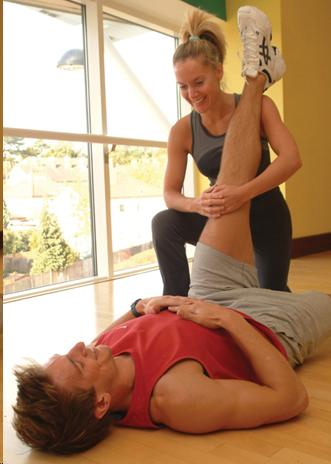Lecture Notes
The next type of stretching exercise is called proprioceptive neuromuscular facilitation, or PNF stretching, and here you're really taking advantage of the Golgi tendons that, remember that they cause muscle relaxation when they detect rapid and forceful contraction, and you're using them to help increase flexibility. And so the way this method would work—we'll use the hamstrings as an example as they're pictured here—you have two people, one person lying on the ground that's being stretched, and then you have a partner that has the person's left leg up on their shoulder, and they're really helping their partner on the ground to do this stretching exercise. You can also think of PNF stretching as kind of a hold-and-relax method. So here the hamstring is originally stretched for about 10 seconds, and the partner helps the person on the ground to do that, and then the person on the ground does a max isometric, meaning their leg is not going to move, they're going to press against their partner for about 6 seconds. And again, that partner's job is to make sure that the leg is not moving, so we're not having an isotonic contraction, but we're just having an isometric contraction where the hamstrings are contracting and the partner is providing resistance. Again, you do that for about 6 seconds, then the person on the ground that's being stretched relaxes their hamstrings and the partner slowly pushes them a little further for about 30 seconds into a hamstring stretch again, and this time, the leg should go a little bit further, and you see a little increase in flexibility and range of motion of the hamstring muscle. So really the key here is that PNF stretching is taking advantage of some of those reflexive responses in your tendons to allow for greater muscle flexibility and range of motion at the joints.


